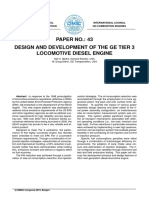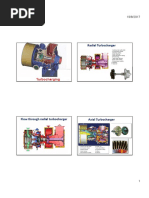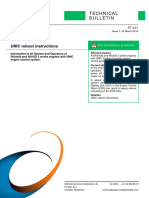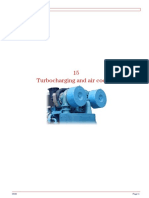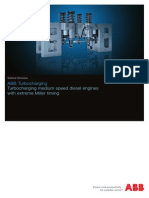TCS-PTG Savings With Extra Power
TCS-PTG Savings With Extra Power
Uploaded by
mieszko9888Copyright:
Available Formats
TCS-PTG Savings With Extra Power
TCS-PTG Savings With Extra Power
Uploaded by
mieszko9888Copyright
Available Formats
Share this document
Did you find this document useful?
Is this content inappropriate?
Copyright:
Available Formats
TCS-PTG Savings With Extra Power
TCS-PTG Savings With Extra Power
Uploaded by
mieszko9888Copyright:
Available Formats
TCS-PTG
Savings with extra power
TES Thermal Efficiency Systems A proven method of increasing efficiency in 2-stroke diesel power systems
The Turbocharger business unit of MAN Diesel & Turbo has launched an updated product in its TES range of proven efficiency-enhancing solutions for 2-stroke engines in marine and stationary applications. With the TCS-PTG (Turbo Compound System with Power Turbine and Generator) up to 5% of additional power can be extracted from the main engine exhaust gases. Depending on the size of the MAN Diesel & Turbo engine involved, a maximum of 4,700 kW can be produced. The additional power output from the TCS-PTG system is in the form of 50 or 60 Hz electrical energy for the onboard power grid. The power turbine is inserted into the exhaust gas system parallel to the turbochargers. It drives an electrical generator via a reduction gearbox and receives up to 13% of the exhaust gas flow, diverted from the main engine exhaust gas receiver. With this TCS-PTG stand alone solution in operation, auxiliary engine fuel, emissions and maintenance costs can be saved and generator set maintenance more flexibly planned and carried out with the ship underway! Used in combination with MAN Diesel & Turbo high efficiency turbochargers on the main engine, and depending on fuel oil prices, payback periods as short as 2 to 3 years can be achieved.
TCS-PTG Savings with extra power
03
Enjoy the Benefits
Technical data
TCS-PTG based on TCR TCS-PTG18 TCS-PTG20 TCS-PTG22 TCS-PTG based on TCA TCS-PTG55 TCS-PTG66 Max. output Pel* 850 kW 1,250 kW 2,200 kW Max. output Pel* 3,300 kW 4,700 kW
* The performace data vary to individual layout parameters. Available power based on typical 2-stroke-conditions with MAN Diesel & Turbo high efficiency TCA turbochargers on the main engine (Turbine = 3.3; TEG = 450 C).
Components
Exhaust gas turbine Newly developed high efficiency turbine New turbine nozzle ring with extended life time Bearing arrangement with long life time Axial: based on most modern TCA series Radial: based on most modern TCR series Gearbox High efficiency high speed gearbox reducing turbine speed to generator speed Couplings Gearbox to generator: high flexible coupling Generator Synchronous generator suited to marine applications Asynchronous generator suited to stationary applications Exhaust gas system Control valves for power turbine operating range Fast acting emergency valves for emergency shutdown Control and saftey equipment Optional: Variable Turbine Area (VTA) for exhaust gas turbine Increasing efficiency and flexibility of operation
04
TCS-PTG Savings with extra power
Extraction of exhaust gas to power turbine before turbochargers.
Turbochargers Funnel (Boiler)
Generator
Coupling
Exhaust gas receiver
Main engine
Board grid
Gearbox
Exhaust gas turbine
Maximum power output with MAN Diesel & Turbo TCA high efficient turbochargers on the main engine and TCA/TCR based power turbine
Turbocharger Efficiency B&W def 50.0 60.0 Engine Load in % 70.0 80.0 90.0 100.0
Max. Turbocharger Efficiency
72.0
Enlarge gap for maximum power!
68.0
64.0
Min. Charging Efficiency 60.5%
TCS-PTG Savings with extra power
05
Estimation of Fuel Oil Saving Potential of TCS-PTG Units
TCS-PTG-systems offer enormous saving potentials in 2-stroke engine applications. By generating additional power output, both fuel oil costs and CO emissions can be reduced at the auxiliary engines. For stationary applications additional power can be generated which can be supplied directly to the grid. For estimating the saving potential of these systems, diagrams 1 to 3 based on ISO ambient reference conditions) help to quantify the advantages for an individual application case.
Example 12K98ME7 with 3x TCA88 turbochargers on a container vessel
1 With main engine output at SMCR, exhaust gas pressure ratio and temperature known, the potential of an applicable TCS-PTG system can be estimated. For this example a 12K98ME7 with 74,760 kW at 97 rpm at SMCR is chosen. Best application for this engine is a TCS-PTG55 with a power output of 3,150 kW electrical. 2 Estimation of an appropriate load profile is done
Diagrams and estimates are based on the use of high efficiency TCA turbochargers on the main engine. The layout of such a turbo compound system must be custom designed to take account of variables like exhaust gas pressure, temperature and mass flow. In this way each individual system may vary in terms of performance.
with help of diagrams 1 & 2. 3 Calculation of average TCS-PTG power output: a TCS-PTG load is dependent on main engine load (diagram 1). By combining the TCS-PTG load points from diagram 2 with main engine load profile from diagram 1 the average TCS-PTG load is obtained as a percentage value:
1 Load profile example
Engine power output / % of SMCR 0 10 20 30 40 50 60 70 80 90 100 Engine load profile / % of operating hours (OH)
2 TCS-PTG load in relation to main engine load
TCS-PTG power output / % 0 10 20 30 40 50 60 70 85 100 Main engine power output / %
100 90 80 70 60 50
TCS-PTG shut down below 50% engine load
10% 80% 10%
100 90 79 70 60 50 40 30 20 10
TCS-PTG shut down below 50% engine load
Main engine load profile
TCS-PTG power output related to main engine power output
06
TCS-PTG Savings with extra power
Readings out of Diagram 1 & 2
10% of OH at 100% load 80% of OH at 85% load 10% of OH < 50% load 100% TCS-PTG power output 79% TCS-PTG power output 0% TCS-PTG power output
Conclusions
In stationary applications additional power output can be gained equivalent to nearly 100% of TCS-PTG related load. For marine applications a TCS-PTG offers following advantages:
n n
b Average TCS-PTG output is calculated as the following:
10 % x 100 % + 80 % x 79 % + 10 % x 0 % 100 %
= 73.2 %
High fuel oil saving potential on auxiliary engines Reducing running hours and thus maintenance of auxiliary engines Reduction of emissions
Average TCS-PTG load is 73.2% Average TCS-PTG power output is 2.3 MW
Save your money and save your environment with 4 Assuming 6,000 OH and above TCS-PTG average power output, approximately 2,800 tons of fuel oil can be saved per year at the auxiliary engines (diagram 3). 5 Taking the current fuel prices in to account, annual cost savings can be estimated. MAN Diesel & Turbo TCS-PTG systems. Economically and ecologically optimized vessels.
Make your vessel an ECO-Vessel.
Please note: Main engines fuel consumption might increase between 0.0-1.8%, depending on the application and turbocharger efficiency. Also exhaust gas temperature will rise.
3 Fuel oil savings in relation to operating hours
Fuel oil savings / tons per year
0 0.5 1.0 1.5 2.0 2.5 3.0 3.5 4.0 4.5
Payback time vs. average engine load
Average engine load / % Payback time
60 70 80 90 100
Average TCS-PTG power output / MW
7,000 6,000 5,000 4,000 3,000 2,000 1,000
Calculation auxialiary engine fuel oil savings related to TCS-PTG power output 2.3 MW
Savings: ~2,800 t/y
Main engine operating hours (OH) per year 7,000 OH 6,000 OH 5,000 OH
TCS-PTG Savings with extra power
07
Schematic of the Valve System
Exhaust gas receiver
Funnel
EE
BP
EE 1 BP 2 3
Exhaust gas extraction Valves Bypass Valves Orifice
Exhaust gas diverted before turbochargers Control and emergency valve power turbine Bypass dispensable exhaust gas Control and emergency valve bypass Orifice simulates p of power turbine in shut down cases above 50% engine load
08
TCS-PTG Savings with extra power
Scope of Supply
One complete TCS-PTG unit includes following items:
1 Exhaust gas driven power turbine including:
Speed pick-up Speed indicating instrument Turbine cleaning device Operating manuals Set of tools
2 Gearbox 3 Coupling PTG-generator 4 Synchronous or asynchronous generator
5 Mounting of turbine, gearbox and generator on base frame
6 Control and safety equipment consisting of:
Control valves Emergency valves TCS-PTG-control cabinet incl. TCS-PTG-software
7 Thermodynamic layout
TCS-PTG Savings with extra power
09
World Class Service Around the clock
PrimeServ Peace of mind for life
Customer support for turbochargers is vital MAN Diesel & Turbo provides a worldwide service network for repairs and maintenance. A fast delivery of spare parts is of utmost importance to avoid down times. MAN Diesel & Turbo has an efficient processing and stock despatch system allowing parts to be delivered within 24 hours. Continuous training of engineers, combined with regular service bulletins and video clips ensures the worldwide service network is always up to date. A customer feedback programme also contributes to maintaining a high standard of service. Close co-ordination with all licensees ensures that products built under licence are fully covered by our global network.
Enjoy the benefits
n
Knowledgeable partners in more than 150 service stations worldwide A one stop service for turbochargers, diesel and gas engines Around the clock after sales service Largest turbocharger license net with full exchangeability of spare parts A high availability of spare parts through an intelligent central stocking system Attractive price/performance ratio
n n
10
TCS-PTG Savings with extra power
Copyright MAN Diesel & Turbo
Subject to modification in the interest of technical progress.
D2366350EN-N1 Printed in Germany MC-04102
MAN Diesel & Turbo 86224 Augsburg, Germany Phone +49 821 322-0 Fax +49 821 322-3382 turbochargers@mandieselturbo.com www.mandieselturbo.com
You might also like
- Civil Engineering Reference Manual, Fifteenth Edition0% (2)Civil Engineering Reference Manual, Fifteenth Edition196 pages
- 2019 - Mitsubishi Low Speed Engine CatalogueNo ratings yet2019 - Mitsubishi Low Speed Engine Catalogue41 pages
- ABB Turbocharging TPS - . - F33 - A New Series of Small TurbochargersNo ratings yetABB Turbocharging TPS - . - F33 - A New Series of Small Turbochargers2 pages
- KTS - Caracteristicas EVERDIGM Modelo ECD (Eng)100% (2)KTS - Caracteristicas EVERDIGM Modelo ECD (Eng)4 pages
- Maintenance Program For HFO Diesel EngineNo ratings yetMaintenance Program For HFO Diesel Engine11 pages
- TCA Project Guide - Document - MAN Diesel & Turbo100% (1)TCA Project Guide - Document - MAN Diesel & Turbo120 pages
- Man B&W K90Me9-Tii: Project Guide Electronically Controlled Two Stroke EnginesNo ratings yetMan B&W K90Me9-Tii: Project Guide Electronically Controlled Two Stroke Engines347 pages
- Product Safety Warning For TCR14, TCR16, TCR18, TCR20 and TCR22 TurbochargersNo ratings yetProduct Safety Warning For TCR14, TCR16, TCR18, TCR20 and TCR22 Turbochargers7 pages
- Turbocharger System 612.01: Description Page 1 (2) Edition 22HNo ratings yetTurbocharger System 612.01: Description Page 1 (2) Edition 22H7 pages
- Doosan Engine Co., LTD.: Type S50MC-C Instructions For Main Engines100% (1)Doosan Engine Co., LTD.: Type S50MC-C Instructions For Main Engines11 pages
- Volume Iii-Components Descriptions: Edition 1No ratings yetVolume Iii-Components Descriptions: Edition 12 pages
- Chapter 15 - (Bi) Turbocharging and Air CoolingNo ratings yetChapter 15 - (Bi) Turbocharging and Air Cooling20 pages
- RTA-71 Retrofit For Fuel Injection Pump Block For RTA96C and C-B EnginesNo ratings yetRTA-71 Retrofit For Fuel Injection Pump Block For RTA96C and C-B Engines14 pages
- Service Bulletin S - 5.1: Technical Information To All Owners / Operators of Sulzer S20 Engines 08.11.99No ratings yetService Bulletin S - 5.1: Technical Information To All Owners / Operators of Sulzer S20 Engines 08.11.999 pages
- ABB Turbocharging - Operating Turbochargers PDFNo ratings yetABB Turbocharging - Operating Turbochargers PDF35 pages
- Cetane Number: University of Karbala College of Engineering Third StageNo ratings yetCetane Number: University of Karbala College of Engineering Third Stage7 pages
- Turbocharger TCR22 - Refitting The Silencer: Application ReasonNo ratings yetTurbocharger TCR22 - Refitting The Silencer: Application Reason2 pages
- ABB - Turbocharging - Turbocharging Medium Speed Diesel Engines...No ratings yetABB - Turbocharging - Turbocharging Medium Speed Diesel Engines...20 pages
- 6month (Idins) - Control Valve Function Test and Positioner CalibrationNo ratings yet6month (Idins) - Control Valve Function Test and Positioner Calibration3 pages
- Development High-Efficiency Turbocharger Met-MaNo ratings yetDevelopment High-Efficiency Turbocharger Met-Ma3 pages
- Turbocharger Choice: MAN B&W Diesel A/S S26MC Project GuideNo ratings yetTurbocharger Choice: MAN B&W Diesel A/S S26MC Project Guide10 pages
- Turbonews: TCS-PTG Turbo Compound SystemsNo ratings yetTurbonews: TCS-PTG Turbo Compound Systems0 pages
- Fujifillm GHG Inventory Report ISO14064-1No ratings yetFujifillm GHG Inventory Report ISO14064-114 pages
- MIPLM Industry Case Study Series Hilti PDFNo ratings yetMIPLM Industry Case Study Series Hilti PDF28 pages
- Duty Specification FOR Hot Oil System Package Unit: GeneraNo ratings yetDuty Specification FOR Hot Oil System Package Unit: Genera5 pages
- United Republic of Tanzania: Procurement PlanNo ratings yetUnited Republic of Tanzania: Procurement Plan7 pages
- Simulation of Air Liquefaction Using Aspen PlusNo ratings yetSimulation of Air Liquefaction Using Aspen Plus39 pages
- Technical Requirements For Electrical EquipmentNo ratings yetTechnical Requirements For Electrical Equipment20 pages
- Literature Review On Manufacturing Technology100% (3)Literature Review On Manufacturing Technology8 pages
- PT - PN.03.24.0015 - Fornecimento de Energia Elétrica em Tensão Secundária - Edificações Coletivas PDFNo ratings yetPT - PN.03.24.0015 - Fornecimento de Energia Elétrica em Tensão Secundária - Edificações Coletivas PDF193 pages
- Catalog of Dairy Farm Milking and Dairy Equipments (HAILIAN - CHUANGPU)50% (2)Catalog of Dairy Farm Milking and Dairy Equipments (HAILIAN - CHUANGPU)65 pages
- Báo Giá Cty PLG - PT TB Phun Bi 2024 - TT 2025.No ratings yetBáo Giá Cty PLG - PT TB Phun Bi 2024 - TT 2025.1 page
- Process of Tender: Presented By:-Abhinav, Adityan, Afreen, Amir, Gursharan, Hamdan, Mayank, Salman, Sumaiya, TalhaNo ratings yetProcess of Tender: Presented By:-Abhinav, Adityan, Afreen, Amir, Gursharan, Hamdan, Mayank, Salman, Sumaiya, Talha25 pages
- Civil Engineering Reference Manual, Fifteenth EditionCivil Engineering Reference Manual, Fifteenth Edition
- ABB Turbocharging TPS - . - F33 - A New Series of Small TurbochargersABB Turbocharging TPS - . - F33 - A New Series of Small Turbochargers
- TCA Project Guide - Document - MAN Diesel & TurboTCA Project Guide - Document - MAN Diesel & Turbo
- Man B&W K90Me9-Tii: Project Guide Electronically Controlled Two Stroke EnginesMan B&W K90Me9-Tii: Project Guide Electronically Controlled Two Stroke Engines
- Product Safety Warning For TCR14, TCR16, TCR18, TCR20 and TCR22 TurbochargersProduct Safety Warning For TCR14, TCR16, TCR18, TCR20 and TCR22 Turbochargers
- Turbocharger System 612.01: Description Page 1 (2) Edition 22HTurbocharger System 612.01: Description Page 1 (2) Edition 22H
- Doosan Engine Co., LTD.: Type S50MC-C Instructions For Main EnginesDoosan Engine Co., LTD.: Type S50MC-C Instructions For Main Engines
- RTA-71 Retrofit For Fuel Injection Pump Block For RTA96C and C-B EnginesRTA-71 Retrofit For Fuel Injection Pump Block For RTA96C and C-B Engines
- Service Bulletin S - 5.1: Technical Information To All Owners / Operators of Sulzer S20 Engines 08.11.99Service Bulletin S - 5.1: Technical Information To All Owners / Operators of Sulzer S20 Engines 08.11.99
- Cetane Number: University of Karbala College of Engineering Third StageCetane Number: University of Karbala College of Engineering Third Stage
- Turbocharger TCR22 - Refitting The Silencer: Application ReasonTurbocharger TCR22 - Refitting The Silencer: Application Reason
- ABB - Turbocharging - Turbocharging Medium Speed Diesel Engines...ABB - Turbocharging - Turbocharging Medium Speed Diesel Engines...
- 6month (Idins) - Control Valve Function Test and Positioner Calibration6month (Idins) - Control Valve Function Test and Positioner Calibration
- Turbocharger Choice: MAN B&W Diesel A/S S26MC Project GuideTurbocharger Choice: MAN B&W Diesel A/S S26MC Project Guide
- Duty Specification FOR Hot Oil System Package Unit: GeneraDuty Specification FOR Hot Oil System Package Unit: Genera
- PT - PN.03.24.0015 - Fornecimento de Energia Elétrica em Tensão Secundária - Edificações Coletivas PDFPT - PN.03.24.0015 - Fornecimento de Energia Elétrica em Tensão Secundária - Edificações Coletivas PDF
- Catalog of Dairy Farm Milking and Dairy Equipments (HAILIAN - CHUANGPU)Catalog of Dairy Farm Milking and Dairy Equipments (HAILIAN - CHUANGPU)
- Process of Tender: Presented By:-Abhinav, Adityan, Afreen, Amir, Gursharan, Hamdan, Mayank, Salman, Sumaiya, TalhaProcess of Tender: Presented By:-Abhinav, Adityan, Afreen, Amir, Gursharan, Hamdan, Mayank, Salman, Sumaiya, Talha

















